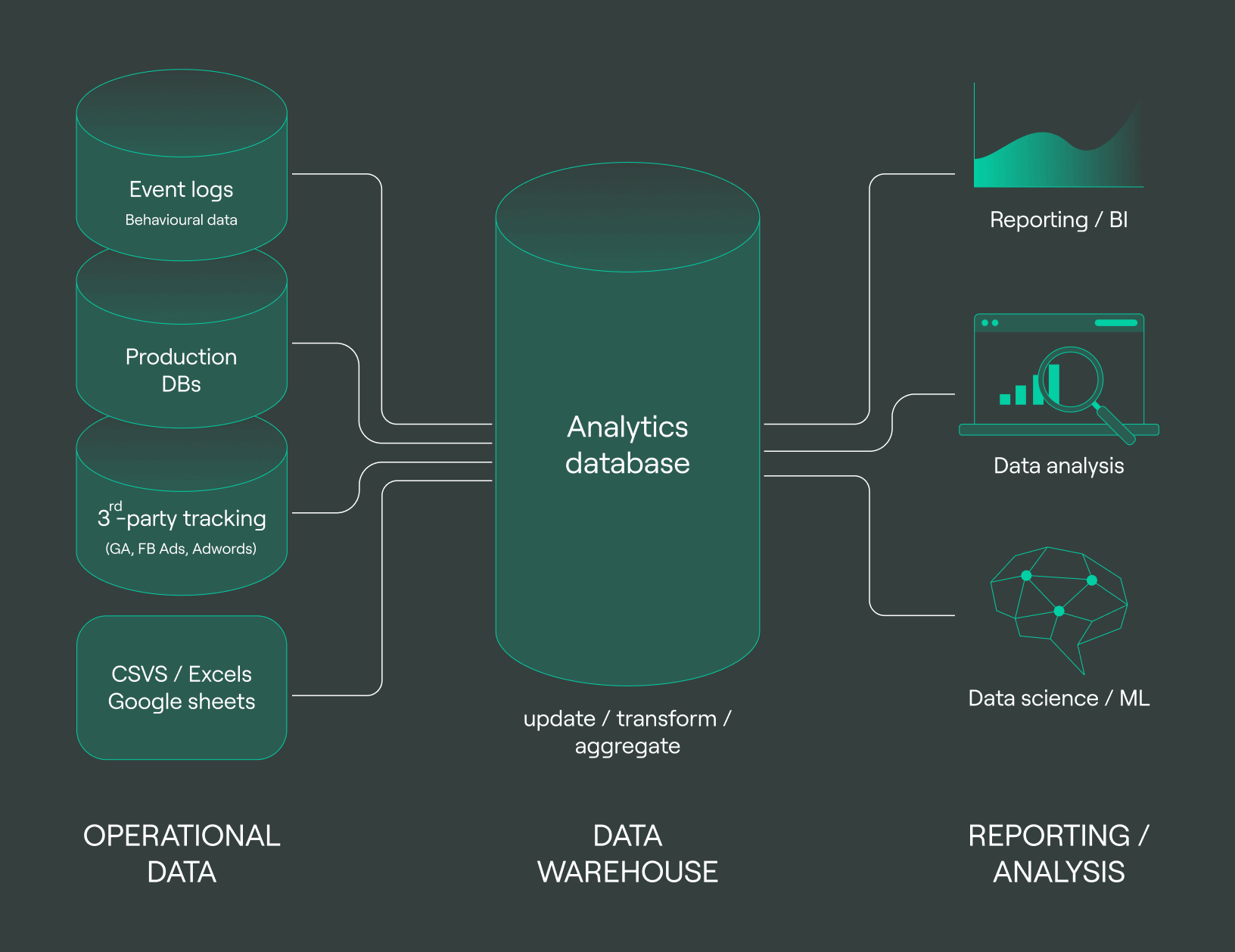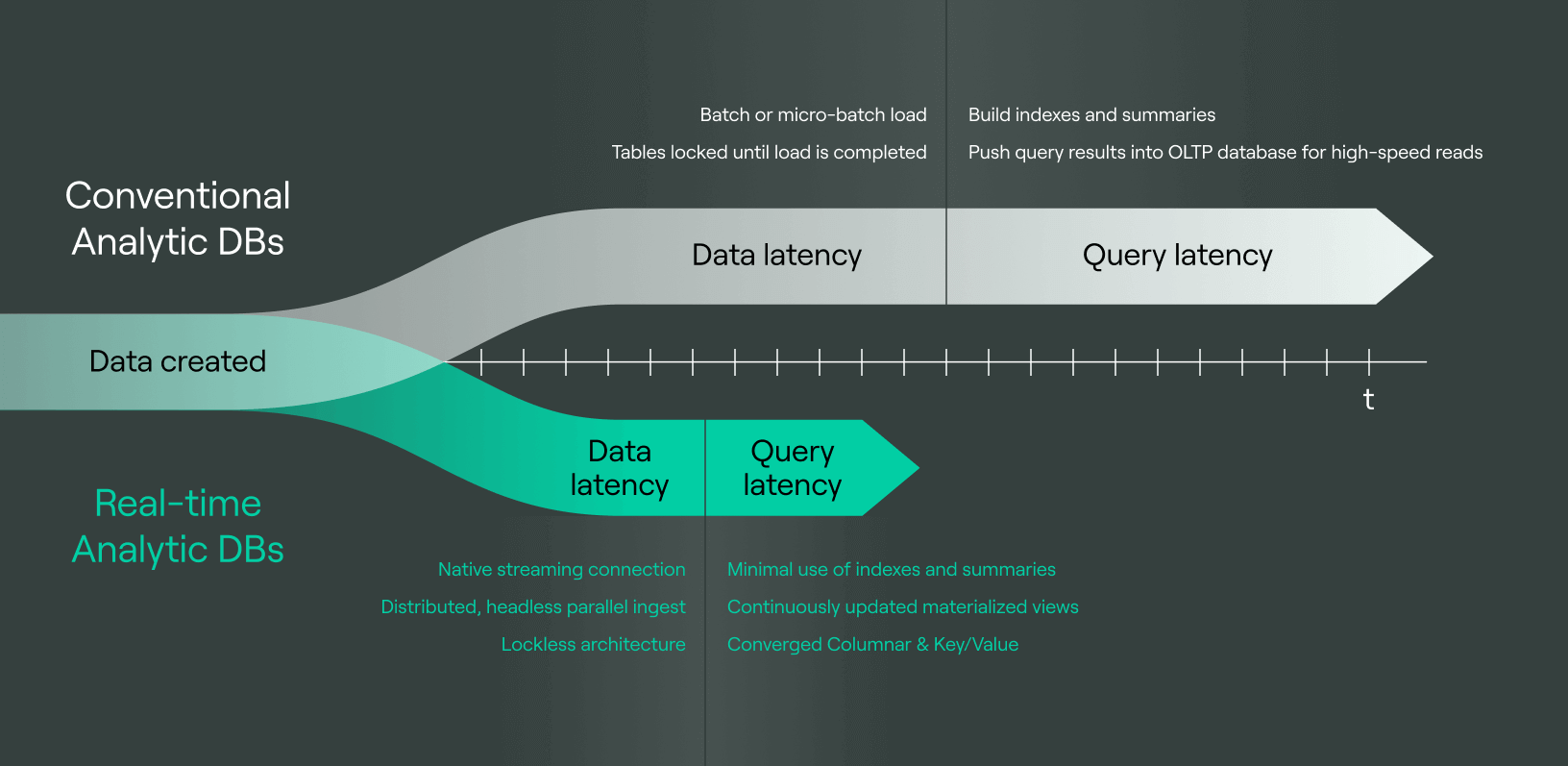
Real-time analytics databases: Empowering decision-making
In today’s fast-paced world, businesses are reaping the benefits of real-time analytics databases. These databases enable organizations to seamlessly merge data, analyze it instantly, and generate insights and actionable information without delay.
Unlike traditional databases that rely on time-consuming batch processing, real-time analytics databases represent cutting-edge solutions that empower businesses to efficiently process and analyze vast amounts of data in real-time or nearly real-time. This article explores the world of real-time databases, their benefits, and their differences from traditional databases.
What is real-time analytics database?
The capacity to store, analyze, and retrieve data at breakneck rates is necessary for contemporary enterprises that want to make data-based decisions. Businesses have been forced to reassess their infrastructure options due to the massive growth in the amount and type of data gathered. Databases underlie all of these options.
Deriving value from data is challenging in typical relational database systems because the data must be moved around, altered, and placed into a data warehouse or a data lake before the company can consume it. This multistep procedure takes a long time — often a few hours, but occasionally days.
Streaming engines like Kafka can assist, but only to a central coordination point, since they can only aid with creating and consuming data in its current state and do not provide analytics on streaming data. The essential need was for a database capable of processing large volumes of data in real-time, which is what a real-time analytics database accomplishes.
Real-time databases manage massive quantities of your data by optimizing resources to support data ingestion and compute-intensive applications. This is done via a huge parallel processing architecture with a high rate of concurrency designed so that enormous infrastructure expenditures are avoided.

In this article, we’ll talk about:
Growing importance of data analytics in business operations
The most important resource in the 21st century is data. Suppose you observe a business altering its pricing, marketing approach, etc. In that case, it is likely because it continually examines historical data trends and identifies adjustments that will strengthen its position in the market. This will enable them to outperform competing brands and create a new data market.
Although data warehouses are suitable for use cases requiring the integration of several data sources, they are often inefficient for real-time analytics. Data visualization was predicted to have a global market worth $7.76 billion by 2023, up 9.47% from 2017.
Data warehouses are built with the long term in mind. They are intended to meet precise, organized reporting and analytics needs that you may need to fulfill over an extended period.
Analytics databases are designed to handle comparable query workloads but with the additional restriction of time sensitivity. Because of this limitation, they are designed to be more adaptable to a wide range of data formats, with built-in optimizations for fast data intake and consumption.
Data warehouses and real-time databases share many architectural aspects. Both kinds of databases, for example, can leverage massively parallel processing to provide distributed computing for quicker query returns. However, there are substantial variations between the two, particularly in terms of adjusting to dynamic workloads.
One example is an analytics database’s capacity to scale up and down depending on real-time data needs. A conventional data warehouse is simply not built or equipped to do so due to its architecture and the operations that power it.
Key differences between traditional databases and real-time analytics databases
A traditional database, also called a relational database, follows the relational model and relies on tables to store data. Its primary purpose is to handle data. It is well suited for tasks like recording financial transactions or managing inventory. In order to retrieve and manipulate data, traditional databases utilize SQL (Structured Query Language) while ensuring the consistency and integrity of the data through ACID (Atomicity, Consistency, Isolation, Durability) transactions. Some examples of traditional databases include MySQL, Oracle, and Microsoft SQL Server.
On the other hand, an analytical database or a data warehouse is specifically designed to handle vast amounts of data and complex queries. It excels in read-intensive operations and finds extensive use in data analysis and business intelligence applications. Analytical databases organize data into dimensions and facts using a star or snowflake schema. They also support OLAP (Online Analytical Processing) queries that enable business users to slice and dice the data in many ways for analysis.
Additionally, analytical databases have functionalities such as data mining and predictive analytics. Some popular examples of databases include Google BigQuery, Amazon Redshift, and Microsoft Azure SQL Data Warehouse.

Best real-time analytics databases
This plays a pivotal role in enabling organizations to access and analyze data instantaneously, providing the right insights to drive strategic decision-making. Based on their unique features, strengths, and use cases, here are some of the best analytics databases:
1. AWS Kinesis
AWS Kinesis is a powerful real-time analytics database that offers high scalability and low latency for streaming data processing. It allows organizations to collect, process, and analyze huge amounts of data in real-time, enabling them to make informed decisions quickly. With its ability to handle high throughput and provide real-time insights, AWS Kinesis is a popular choice for healthcare providers leveraging data analytics for operational efficiency and improved patient care.
2. Kafka
Kafka is another leading real-time analytics database that is widely used in various industries. One of the key reasons why Kafka is considered a top choice is its distributed architecture, which allows for high fault tolerance and scalability. This means that healthcare providers can handle large volumes of data and ensure the continuous availability of their analytics platform.
If you’re interested in working with Kafka, you can leverage the DoubleCloud-managed Kafka platform, which provides a user-friendly interface for monitoring and managing Kafka clusters. With the DoubleCloud-managed Kafka platform, healthcare organizations can easily configure and scale their clusters based on specific needs. This allows them to efficiently handle the increasing amount of data generated in the healthcare industry while ensuring smooth and uninterrupted data processing.
3. ClickHouse
ClickHouse is a powerful analytics database with efficient query processing and a columnar storage architecture. With ClickHouse, organizations can process and analyze large volumes of data in real-time or near real-time without the need for time-consuming batch processing. One of the critical advantages of ClickHouse is its compatibility with SQL queries, making it easy for developers and analysts to work with.
Additionally, you can leverage the DoubleCloud-managed ClickHouse platform to simplify your operations and work with ClickHouse effortlessly on your terms.
4. Druid
Druid is another popular open-source data store that is designed for real-time analytics. It is built to handle high real-time data ingestion rates and provide sub-second query performance times, making it ideal for applications that require fast and interactive analytics. Druid uses a column-oriented storage format and employs a distributed architecture to scale horizontally and handle multiple data elements. Druid, like ClickHouse, allows SQL-like querying, making it simple for users comfortable with SQL to interact with the system.
5. Flink
Flink, an open-source stream processing machine learning framework, provides high-throughput, low query latency processing of continuous data streams. It is designed to handle real-time data processing at scale and offers fault-tolerance and exactly-once processing data semantics.
Flink supports multiple data sources, individual data elements, and sinks, including Kafka, Hadoop, and Elasticsearch, making it a versatile tool for building real-time analytics applications. Additionally, Flink provides a rich set of operators and functions for data transformations and aggregations, allowing users to perform complex computations on streaming data.
6. Firebase
This mobile and web application development platform offers various backend services to help developers build high-quality apps quickly. Its features include authentication, a real-time database, cloud storage, and hosting. Firebase’s real-time database is beneficial for building real-time applications, as it synchronizes data across devices in real-time. This makes it a great choice for building collaborative apps or apps that require real-time updates.
Additionally, Firebase’s authentication service provides easy-to-use authentication methods, including email/password, social login, and anonymous authentication, making adding user authentication to an application simple.
Benefits of real-time analytics databases
Real-time analytics databases offer numerous benefits for businesses and developers alike. These databases enable organizations to make informed decisions and optimize their query operations by providing real-time insights and data analysis. Let’s have a look at some benefits below:
-
Enhanced decision-making capabilities through up-to-the-minute data insights: Real-time analytics databases allow businesses to access and analyze data simultaneously in real-time, providing them with up-to-the-minute insights to inform decision-making processes. This enables businesses to react quickly to changes in the market or customer behavior, ensuring they stay ahead of the competition.
-
Improved operational database efficiency and agility in responding to changing market dynamics. These advantages eventually lead to higher customer satisfaction and loyalty because firms can produce goods and services that meet their customers’ demands and preferences. Real-time analytics databases also enable organizations to identify and address potential issues or bottlenecks before they become major problems, saving time and resources.
-
Empowering data analysts with instant access to real-time data for ad-hoc analysis. This capability allows data analysts to quickly respond to changing business needs and make informed decisions on the spot. Additionally, real-time analytics databases enable data analysts to uncover valuable insights and trends in real-time, driving innovation and the organization forward. Firms can remain ahead of the competition by empowering those with data science and analysis knowledge with instant access to real-time data and leveraging opportunities as they arise.
-
Enabling data-driven automation and actionable insights for DevOps teams. Data-driven automation and actionable insights are crucial for DevOps teams to streamline processes and improve efficiency. By leveraging real-time analytics databases, DevOps teams can monitor performance metrics, detect anomalies, and identify bottlenecks in real-time.
Conclusion
Real-time analytics databases offer several key benefits and are important in various industries. These databases enable healthcare organizations to make informed decisions and take immediate action based on up-to-date and accurate data. They provide real-time insights into patient care, operational efficiency, and financial query performance, ultimately improving outcomes and cost savings.
For data engineers, DevOps, and data analysts, leveraging analytics databases opens up new opportunities for data-driven decision-making and innovation. By harnessing the power of real-time data, they can uncover valuable insights, identify trends, and develop predictive models that can improve patient outcomes, optimize resource allocation, and enhance overall system efficiency.

DoubleCloud Managed Service for ClickHouse
An open-source, managed ClickHouse DBMS service for sub-second analytics. Don’t take two days to set up a new data cluster. Do it with us in five minutes.
Frequently asked questions (FAQ)
What are the key factors to consider when selecting a real-time analytics database for my business?
What are the key factors to consider when selecting a real-time analytics database for my business?
When selecting a real-time analytics database for your business, it is important to consider factors such as scalability, data integration capabilities, and security features. Scalability ensures that the database can handle increasing data as your business grows.
Data integration capabilities allow for seamless integration with other systems and data sources. Security features are crucial to protecting sensitive information and ensuring compliance with data privacy regulations.
How does real-time analytics database differ from traditional databases in terms of data processing speed and latency?
How does real-time analytics database differ from traditional databases in terms of data processing speed and latency?
How can a real-time analytics database enhance decision-making and improve operational efficiency for small and medium-sized businesses?
How can a real-time analytics database enhance decision-making and improve operational efficiency for small and medium-sized businesses?
What are the typical use cases where real-time analytics databases
What are the typical use cases where real-time analytics databases
Start your trial today



